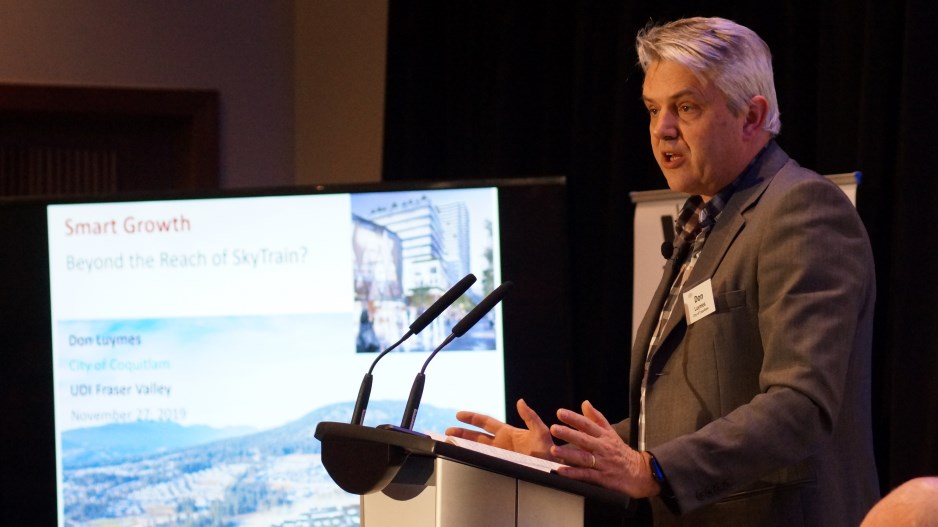Greater suburban sprawl, such as that occurring in Coquitlam and elsewhere beyond Vancouver, can be justified as sustainable if it’s paired with technological advancements, dense housing and an investment in the public realm.
That’s one of the main messages some suburban Metro Vancouver developers and Surrey politicians heard Wednesday at an Urban Development Institute (UDI) forum on “smart growth,” or “smart development,” which is centred on supporting population growth while mitigating environmental damage by reducing land use and car dependence.
Don Luymes, manager of civic lands and facilities for the City of Coquitlam, told his audience at Surrey’s Civic Hotel that the planned Burke Mountain Village development is a case in point.
Luymes said although 2,000 new apartments and townhouses are to be built on newly clear-cut forest in a relatively distant corner of the region and with no significant transit connections, smart planning will make it sustainable. The Village, next to existing detached home neighbourhoods, includes commercial space, a major recreation complex with a community centre, a public plaza, and a green corridor with walking and biking trails and a creek.
The city acts as the developer, said Luymes, who is banking on the integrated amenities and people’s desire to telecommute, with advancements in broadband internet, to remain mostly confined to their hyper-dense locale. He said “innovative partnerships,” such as ride sharing, could deliver transportation solutions before the likes of TransLink, the region’s public transportation provider.
“It’s possible to support development away from the umbilical cord of SkyTrain,” said Luymes.
He said such planning failed the City of Abbotsford, where he worked as community planner from 2005-10. There, housing was built before the public realm was planned and implemented.
UDI, a lobby group for development firms, has not been completely on board with Coquitlam’s plan. Last December, it opposed Coquitlam’s rate increases for development cost charges, including so-called voluntary environmental monitoring and maintenance fees.
The Village is to complement Coquitlam’s envisioned regional downtown core, part of a trend by suburban municipalities in the Lower Mainland to pitch new commercial downtowns (Richmond, Surrey and Burnaby being others).
Surrey politicians attending the event, such as Mayor Doug McCallum and Couns. Brenda Locke and Laurie Guerra, will need to grapple with how to move more people within their city after cancelling a light-rail transit system in favour of a SkyTrain extension that’s designed to move people across the region. They’ll also need to contend with developing and densifying the new SkyTrain corridor to justify the business case, which would be tied to ridership.
The forum also heard from developer Bob Ransford of Century Group. Ransford argued suburban neighbourhoods can be densified before transit improvements are earmarked. His company is trying to redevelop a strip mall in Tsawwassen into about 700 apartment units.
Ransford contends new residents will take the bus, and as more development occurs, more frequent bus service will follow. Ransford purports density is a solution to climate change.
“It’s about compact spaces where people can go to meet their needs,” he said.
Century Group’s previous significant project in Delta was a 950-unit low-density development on farmland in the Southlands.
Also supporting the belief that density in the suburbs can be achieved sustainably, however defined, was Cameron McNeill of real estate marketer and developer MLA Canada, who spoke of recent multi-family unit developments in Squamish. He said people are choosing to live and work there, sometimes by telecommuting.
McNeill said younger adults, referred to as “housing consumers,” are willing to live in those aforementioned compact spaces and are “deprioritizing” size and “the picket fence.”
Moderator Gordon Price, former Vancouver city councillor and the former director of the City Program at Simon Fraser University, poured some cold water on some of the panel’s assumptions, namely by questioning whether people are willing to give up on the automobile and detached homes with yards should they have the financial resources.
“Car dependence is still a reality and you still need to build the infrastructure,” said Price, suggesting that a significant reason Squamish is experiencing a building boom is the improvement and expansion of the Sea-to-Sky Highway in 2009, paid for with general taxation revenue by the provincial government.
He also questioned if “smart growth” can be achieved in existing detached home neighbourhoods and not just in underutilized commercial strip malls and forests.
McNeill said diversity is important for smart growth.
“A real mixture of people living together and not having to travel as far as they have to” is smart growth, he said.
McNeill suggested immigrants — who are a significant driver of home purchases in Metro Vancouver — are more willing to accept densified living, particularly if they come from large cities. And Ransford surmised Chinese immigrants in his hometown of Richmond don’t use their newly-acquired detached homes the way they were initially envisioned or used. For example, he said, they tend to entertain at restaurants.




